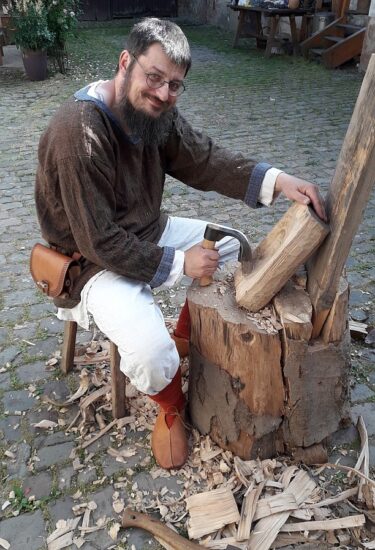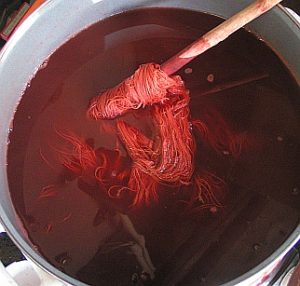Historic fibre-craft combined with high quality wool – this is the philosophy of Alte Künste.
Margit Hofmann is the botanical dyer of Alte Künste. In 2011 she created the label Alte Künste after working together with textile conservators and archaeologists for several years before. From the beginning the goal was to re-introduce high quality & lightfast botanical & natural dyed yarn to modern textile crafts, especially knitting, crocheting & weaving.
The philosophy of Alte Künste is that natural & botanical dyed yarn can indeed be of very high quality that can easily keep up with modern, industrial dyes. On top of that natural & botanical dyes create a unique range of colours that industrial dyes do not reach.
For that reason Alte Künste dyes solely with lightfast plant-material. We deliberately forgo many things from the kitchen and fruit gardens when dyeing our yarn: You are spending many hours working on your textile project & you deserve lasting joy from your work with lasting colours!
Margit got her training in natural and plant dyeing on site from professional natural dyers in France and the UK. The major focus was on historic dyes in order to preserve as well as broaden the knowledge and sustainability of plant-colours. In order to increase the awareness level for natural dyeing and for the quality of plant-dyes we love working with museums.
Beautiful colours belong on beautiful yarn – we attach great importance to high quality yarn for our dyes. The most beautiful colour will only be disappointing if the yarn is of low quality. In order to supply our customers with high quality yarn we are currently dyeing on yarns from Atelier Zitron and some British yarns that Alte Künste imports directly.

Holger Hofmann is the craftsman of Alte Künste. He makes sure that all technical things are running smoothly at Alte Künste.
He is a master craftsman in metalworking. Yes, that’s a traditional profession in Germany going back to the medieval guild systems of Europe.
He also learnt to be a blacksmith in Sweden.
Apart from metal he also has a soft spot for woodworks. Occationally he gives demonstrations on pre-lathe woodworking (photo)
Natural- and plant colours are very extraordinary. Until very recently – compared to human history – they were the only way for people to use colours, and abundantly we have used them! Our highly industrialized world has only little recollection of this blaze of colours. Actually our ancestors loved colours and bright colours were far more popular in the past than we are aware of nowadays.
No wonder historic knowledge on plant-dyes was far more elaborate than it is today.
Yet the process of natural dyeing has been the same for millennia:
- The fibre gets prepared in a mordant-bath, so that it can absorb the plant-dye and keep it permanently.
Only non-hazardous mordants based on alumn are used in my dye-recipes. There are historic dye-recipes that use other mordants, which are hazardous to humans and the environment. I deliberately refrain from using such mordants. - Dyeing the mordanted fibre.
During this stage of the dye-process the fibre gets heated in the dye-liquor. Depending on the individual plant or natural dye the fibre may be heated together with the plant or a decoction.
In order to achieve specific colours or colour-effects this process may have to be repeated several times.

Natural-dyeing is a protracted procedure that takes up several days. During this time I intensely work with the fibre as well as the individual plants and natural colours. Each natural colour has its unique properties and needs in order to unfold its brilliant colour. This is what fascinates me about natural-dyeing: Over time the colours are lured out of the plants and permanently banned onto the fibre, which then can be crafted into a gorgeous new piece of kntting-, crochet, felt-, or spinning-art.
Just like seasons alternate and nature evolves around the wheel of the year, this change of growth, decay and new growth is mirrored during the process of dyeing the fibre and the emerging new piece of craft from it. The natural dyes of my handdyed fibres and yarns reflect this joyous cycle so that it will find its way into your fibre-craft.